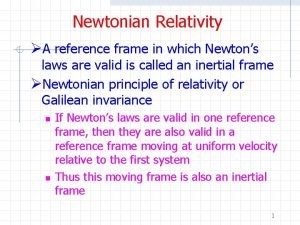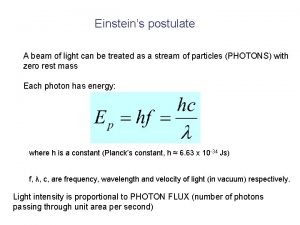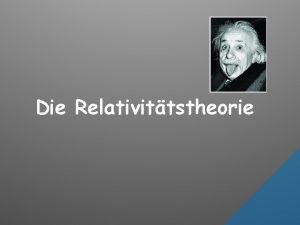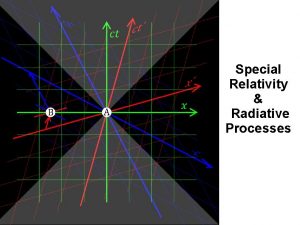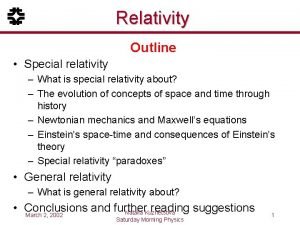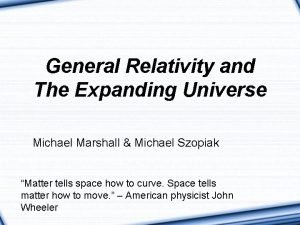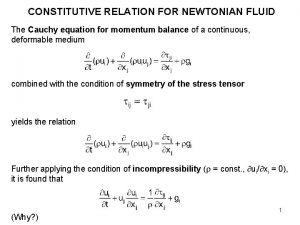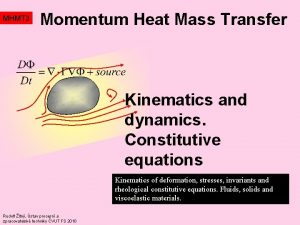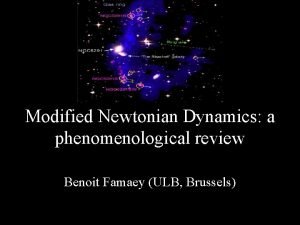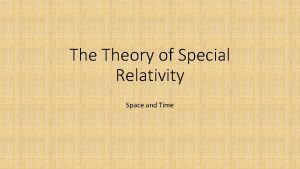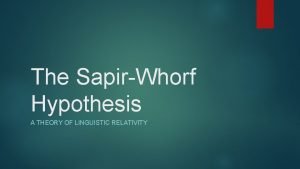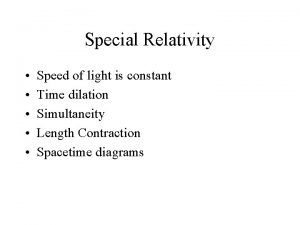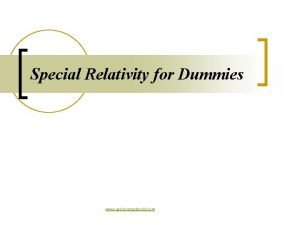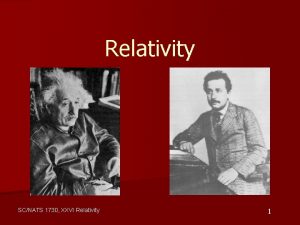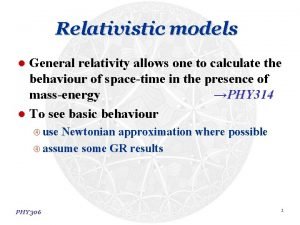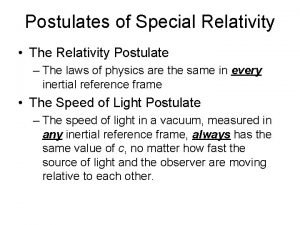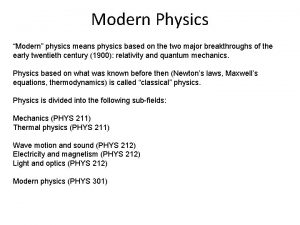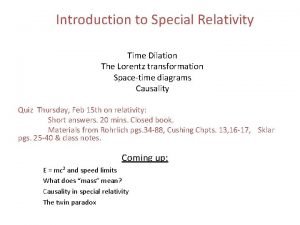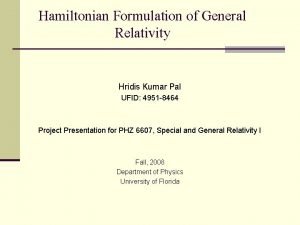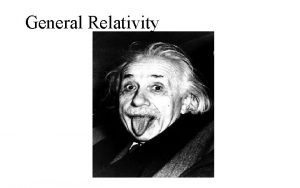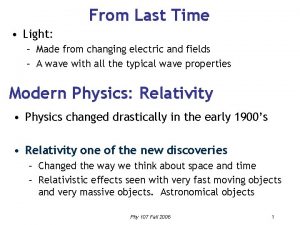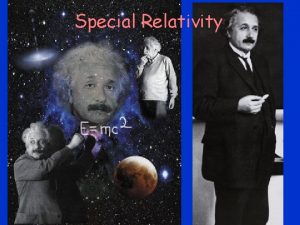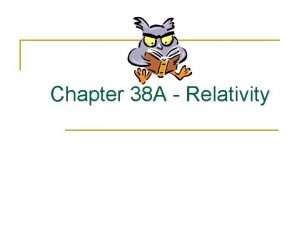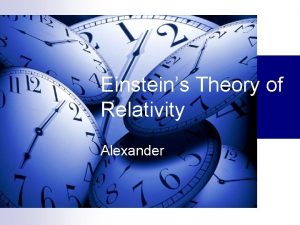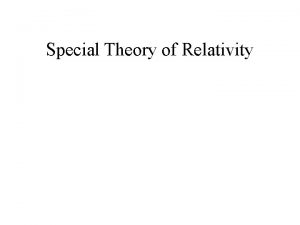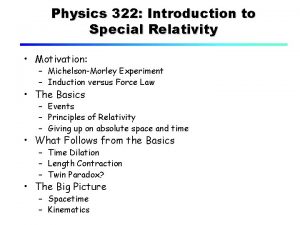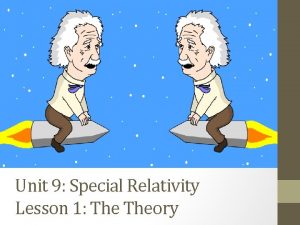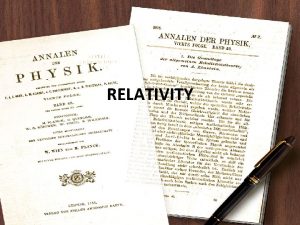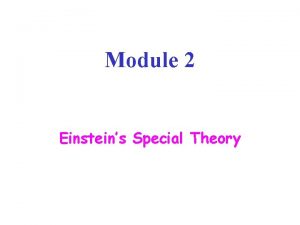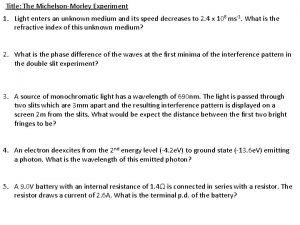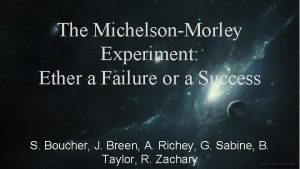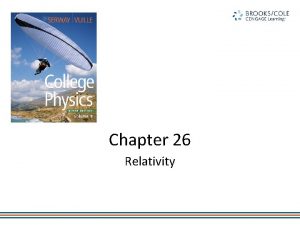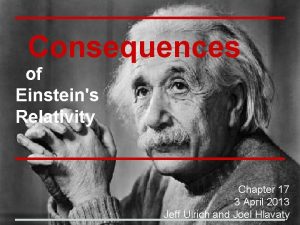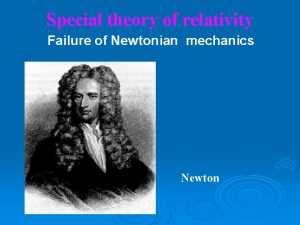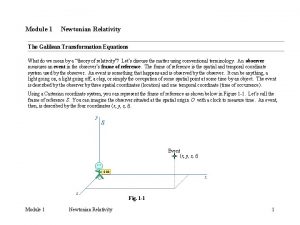Relativity chapter nine Newtonian relativity MichelsonMorley Experiment Einsteins
























- Slides: 24

Relativity (chapter nine) ¬ Newtonian relativity ¬ Michelson-Morley Experiment ¬ Einstein’s principle of relativity ¬ Special relativity ¬ Lorentz transformation ¬ Relativistic momentum and Newton's laws ¬ Relativistic energy ¬ Mass and energy ¬ General relativity

• When glass breaks, the cracks move faster than 3, 000 miles per hour. • Most lipstick contains fish scales! • A 'jiffy' is an actual unit of time for 1/100 th of a second! • Windmills always turn counter-clockwise. Except for the windmills in Ireland! • A sneeze travels out your mouth at over 100 m. p. h. ! • Slugs have 4 noses! • Bats always turn left when exiting a cave! • Most dust particles in your house are made from dead skin!



Principles of Newtonian Relativity Inertial frame = objects experience no acceleration if no forces act on it Newtonian relativity: laws of mechanics same in all inertial reference frames For example: ball thrown straight up in moving truck Truck frame: motion straight up and down Earth frame: parabolic trajectory Galilean transformation of coordinates

Newtonian Relativity Both described by Newtonian mechanics Connection between the two: Galilean transformation of coordinates Galilean addition of velocities

Michelson Morley experiment Simple mechanics obey Newtonian relativity at low speeds, but some laws of E&M do not. Speed of light, measured by Michelson and Morley showed no difference parallel vs. perpendicular to the direction of the earth’s motion. M-M interferometer – measures phase shift of beam in one arm with respect to the other – phase shift should change as interferometer is rotated through 90°. No change was observed. No ether, no absolute inertial frames.

Einstein's principle of relativity 1. All laws of physics are same in all inertial reference frames 2. The speed of light in vacuum has the same value in all reference frames These are the basic postulates of special relativity

Consequences of special relativity The consequences of these two postulates are: 1. There are no absolute standards of length or time. 2. Simultaneity depends on the reference frame. Thought experiment: • Two bolts of lightning strike ends of boxcar • Simultaneous in ground frame • Observer on boxcar sees light from front of boxcar first – concludes that this event occurred first. • Both are correct – the simultaneity of two event depends on the reference frame!

Consequences of special relativity How many relativists does it take to change a light bulb? Two. One holds the bulb, while the other rotates the universe. Second thought experiment: Light emitted vertically in moving train, reflected from mirror. In train reference frame, time interval equals 2 d/c (proper time). In ground frame, light appears to travel a greater distance. Since the speed is the same in both frames, the time interval in the ground frame must be longer.


Length contraction Since time intervals now depends on the reference frame, length will also. The length measured by an observer at rest relative to the object is called the proper length Third thought experiment: spaceship traveling a distance d at speed v. The observer at rest measures a (proper) length Lp. A person in the spaceship sees the distance pass with speed v in time t= tp, and therefore calculates a length

Length contraction Example: You are traveling in a spaceship which you measure to be 100 m long. What length does an observer measure for the spaceship if you pass by at 0. 9 c?

Lorentz transformations The Lorentz transformations relate the relative position in space-time of an event in two reference frames For an observer in frame S’ moving at a speed v along the x-axis

Lorentz transformations From the Lorentz transformations for space-time, one can derive the Lorentz velocity transformations Likewise along the y and z directions Limiting cases: 1) v<<c 2) (Lorentz) 3) 2) ux=c 4) (speed of light same)

Relativistic momentum ¬ Generalize Newton’s laws (2 nd law) –in particular, need conservation of momentum independent of reference frame ¬ Just using the Lorentz transformation to find the velocities does not conserve momentum New definition of momentum: The relativistic force on a particle is (still):

Relativistic energy As with momentum, we need to redefine energy. Starting with the work KE theorem: Matches usual equation (½mv 2) for v<<c

Relativistic energy The second, constant term is called the rest energy: The total energy is this rest energy plus the kinetic energy Mass is a manifestation of energy

Relativistic energy We can rewrite the equation for the total energy in terms of the relativistic momentum Extremely useful formulation – also applies for massless particles, e. g. , photons

General relativity Inertial and gravitational mass - same effects Einstein proposed two postulates of general relativity: 1. All the laws of physics have the same form for observers in any frame of reference 2. In the vicinity of any point, a gravitational field is equivalent to an accelerated reference frame (principle of equivalence).

General relativity Like special relativity, unusual consequences: ¬ Passage of time altered by gravity (experimentally verified - radiation frequency in strong gravitational fields) ¬ Accelerating reference frame "transforms away" gravity (free fall) ¬ Light passing mass - deflected by gravitational field



There was a man who entered a local paper's pun contest. He sent in ten different puns, in the hope that at least one of the puns would win. Unfortunately, no pun in ten did.
 Relatividad de newton
Relatividad de newton De broglie hypothesis
De broglie hypothesis Einsteins postulate
Einsteins postulate Boost interprocess
Boost interprocess General vs special relativity
General vs special relativity Special relativity vs general relativity
Special relativity vs general relativity Newtonian anthropometric data
Newtonian anthropometric data Constitutive relation for newtonian fluid
Constitutive relation for newtonian fluid Impulse = mv-mu
Impulse = mv-mu Newtonian fluid formula
Newtonian fluid formula Modified newtonian dynamics
Modified newtonian dynamics Theory of relativity
Theory of relativity Sapir-whorf hypothesis definition
Sapir-whorf hypothesis definition Special relativity
Special relativity Relativity for dummies
Relativity for dummies Postulates of special theory of relativity
Postulates of special theory of relativity Einstein thought experiment elevator
Einstein thought experiment elevator Relativistic acceleration calculator
Relativistic acceleration calculator Linguistic relativity
Linguistic relativity Postulate
Postulate Modern physics meaning
Modern physics meaning Time dilation presentation
Time dilation presentation Hridis pal
Hridis pal Relativity
Relativity Galilean relativity
Galilean relativity
